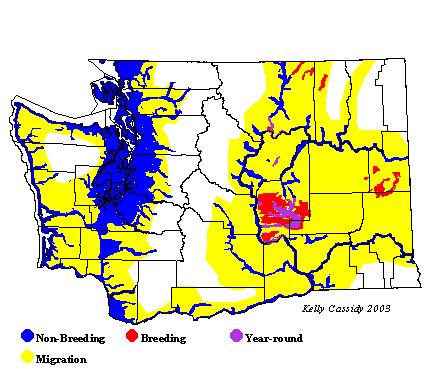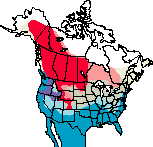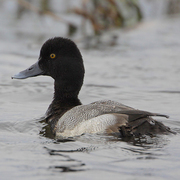Lesser Scaup
General Description
The Lesser Scaup is one of the most abundant diving ducks in the Northwest. Male Lesser Scaups have white flanks, black rumps and breasts, and lined gray backs. They have purplish-black, iridescent heads and yellow eyes. Their bills are light gray-blue. Males in non-breeding plumage have black heads and breasts, brown bodies, and black rumps. Females are brownish overall, also with yellow eyes, and white at the base of their bills. Greater and Lesser Scaups can be difficult to distinguish in the field. Lesser Scaups average about 10% shorter and 25% lighter than Greater Scaups. The Lesser has a peaked, angular head that the Greater lacks. Seen in flight, the white on the Lesser Scaup's wings fades to gray in the primaries. In the Greater Scaup, the white extends into the primaries. As always, taking into account habitat, range, and season may help differentiate between the two species, as well as using a field guide and working with experienced observers.
Habitat
In winter, Lesser Scaups are often found in dense flocks of hundreds and even thousands, on lakes, reservoirs, rivers, and sheltered bays. Lesser Scaup are far more likely than Greater Scaup to be found on fresh water inland during the winter. In summer, nesting habitat is small wetlands with emergent vegetation in boreal forests and parklands. During migration, Lesser Scaups spend their time on rivers, lakes, and large wetlands.
Behavior
Lesser Scaups are divers, and can be very active when feeding. These scaups, like other ducks, form new pair bonds each year. They are one of the latest North American ducks to pair, with most pairs forming late in migration. They are gregarious throughout the year, with the exception of the laying and incubation period.
Diet
Aquatic invertebrates such as insect larvae, crustaceans, and mollusks make up the majority of the Lesser Scaup's diet. Seeds and other parts of plants are also eaten.
Nesting
Most Lesser Scaups probably breed at the age of two, nesting in late May through June. The nests are usually located on dry land close to water, in areas with dense cover, especially bulrush. The female builds the nest, which is a shallow bowl lined with grass and down. She lays 8 to 10 eggs and incubates them for 21 to 27 days. The male leaves when incubation begins. The young leave the nest within a day of hatching and head to the water, where they are tended by the female, but feed themselves. Two or more broods may come together and be cared for jointly by the females. The young fledge at 47 to 54 days, usually in late August or early September.
Migration Status
Lesser Scaups are among the latest migrants moving north in the spring, still moving toward their breeding grounds in mid-May. In the fall, migration is equally late, with the last birds leaving the breeding grounds only when the water freezes.
Conservation Status
Declines have been observed in response to degradation of habitat, but the Lesser Scaup remains one of the most numerous and widespread North American ducks. It is difficult to determine long-term population trends of Lesser Scaup due to the similarity between the two species of scaups, large yearly fluctuations, and the late migration and breeding season of the Lesser Scaup. The North American population is not currently endangered, but is lower than desired by wildlife officials. Protection, restoration, and enhancement of habitats used during all seasons is under way to enable the population to rebound.
When and Where to Find in Washington
Most Lesser Scaups breed north of Washington, in sedge-dominated marshes in boreal climates, but some do breed in Washington. Although they are commonly found year round in appropriate habitat in eastern Washington, they are uncommon breeders here. They are rare and local breeders in lowland ponds in the Puget Trough, with breeding confirmed at the Kent Sewage Ponds (King County), in Everett (Snohomish County), and Whidbey Island (Island County). They are common winter residents (from November to early May) in western Washington, and uncommon non-breeding residents the rest of the year.
 Abundance
Abundance
| Ecoregion | Jan | Feb | Mar | Apr | May | Jun | Jul | Aug | Sep | Oct | Nov | Dec |
|---|---|---|---|---|---|---|---|---|---|---|---|---|
| Oceanic | ||||||||||||
| Pacific Northwest Coast | U | U | U | U | U | R | R | R | U | U | U | U |
| Puget Trough | C | C | C | C | U | U | U | U | U | F | C | C |
| North Cascades | U | U | U | U | R | R | R | R | R | U | U | U |
| West Cascades | C | C | C | C | F | R | R | R | R | U | C | C |
| East Cascades | F | U | U | U | U | R | R | U | U | F | F | F |
| Okanogan | U | U | C | C | C | C | C | C | C | C | C | U |
| Canadian Rockies | F | F | F | C | F | U | U | U | F | C | C | F |
| Blue Mountains | R | R | ||||||||||
| Columbia Plateau | C | C | C | C | C | F | F | F | F | F | C | C |
Washington Range Map

North American Range Map


Family Members
 Fulvous Whistling-DuckDendrocygna bicolor
Fulvous Whistling-DuckDendrocygna bicolor Taiga Bean-GooseAnser fabalis
Taiga Bean-GooseAnser fabalis Greater White-fronted GooseAnser albifrons
Greater White-fronted GooseAnser albifrons Emperor GooseChen canagica
Emperor GooseChen canagica Snow GooseChen caerulescens
Snow GooseChen caerulescens Ross's GooseChen rossii
Ross's GooseChen rossii BrantBranta bernicla
BrantBranta bernicla Cackling GooseBranta hutchinsii
Cackling GooseBranta hutchinsii Canada GooseBranta canadensis
Canada GooseBranta canadensis Mute SwanCygnus olor
Mute SwanCygnus olor Trumpeter SwanCygnus buccinator
Trumpeter SwanCygnus buccinator Tundra SwanCygnus columbianus
Tundra SwanCygnus columbianus Wood DuckAix sponsa
Wood DuckAix sponsa GadwallAnas strepera
GadwallAnas strepera Falcated DuckAnas falcata
Falcated DuckAnas falcata Eurasian WigeonAnas penelope
Eurasian WigeonAnas penelope American WigeonAnas americana
American WigeonAnas americana American Black DuckAnas rubripes
American Black DuckAnas rubripes MallardAnas platyrhynchos
MallardAnas platyrhynchos Blue-winged TealAnas discors
Blue-winged TealAnas discors Cinnamon TealAnas cyanoptera
Cinnamon TealAnas cyanoptera Northern ShovelerAnas clypeata
Northern ShovelerAnas clypeata Northern PintailAnas acuta
Northern PintailAnas acuta GarganeyAnas querquedula
GarganeyAnas querquedula Baikal TealAnas formosa
Baikal TealAnas formosa Green-winged TealAnas crecca
Green-winged TealAnas crecca CanvasbackAythya valisineria
CanvasbackAythya valisineria RedheadAythya americana
RedheadAythya americana Ring-necked DuckAythya collaris
Ring-necked DuckAythya collaris Tufted DuckAythya fuligula
Tufted DuckAythya fuligula Greater ScaupAythya marila
Greater ScaupAythya marila Lesser ScaupAythya affinis
Lesser ScaupAythya affinis Steller's EiderPolysticta stelleri
Steller's EiderPolysticta stelleri King EiderSomateria spectabilis
King EiderSomateria spectabilis Common EiderSomateria mollissima
Common EiderSomateria mollissima Harlequin DuckHistrionicus histrionicus
Harlequin DuckHistrionicus histrionicus Surf ScoterMelanitta perspicillata
Surf ScoterMelanitta perspicillata White-winged ScoterMelanitta fusca
White-winged ScoterMelanitta fusca Black ScoterMelanitta nigra
Black ScoterMelanitta nigra Long-tailed DuckClangula hyemalis
Long-tailed DuckClangula hyemalis BuffleheadBucephala albeola
BuffleheadBucephala albeola Common GoldeneyeBucephala clangula
Common GoldeneyeBucephala clangula Barrow's GoldeneyeBucephala islandica
Barrow's GoldeneyeBucephala islandica SmewMergellus albellus
SmewMergellus albellus Hooded MerganserLophodytes cucullatus
Hooded MerganserLophodytes cucullatus Common MerganserMergus merganser
Common MerganserMergus merganser Red-breasted MerganserMergus serrator
Red-breasted MerganserMergus serrator Ruddy DuckOxyura jamaicensis
Ruddy DuckOxyura jamaicensis

